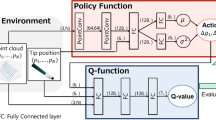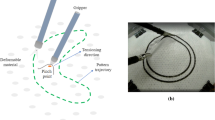Abstract
In recent years, enormous advancement has taken place in biomedical engineering, which has paved the way for robot-assisted surgery in various complex surgical procedures. In robotic surgery, the reinforcement-based Temporal Difference (TD) based approach through assistive approaches has tremendous potential. Probabilistic Roadmap (PR) can be used for recognition of the path to the region of interest without any obstacles and, Inverse Kinematics (IK) approach can be used for the accurate approximation of the pixel space to the real-time workspace. Our proposed system would be more effective in approximating the path length, depth evaluation, and less invasive contact force sensor. This article presents a robust algorithm that would assist in robotic surgery for censorious surgeries in real-time. For working on such soft tissues, software-driven procedures and algorithms must be more precise in choosing the optimal path for reaching out to the procedural region. The statistical analysis has proven that the proposed approach would be outperforming under favorable learning rate, discount factor, and the exploration factor.






Similar content being viewed by others
References
Palep, J.H.: Robotic-assisted minimally invasive surgery. J. Minimal Access Surg. 5(1), 1–7 (2009). https://doi.org/10.4103/0972-9941.51313
Siddaiah-Subramanya, M., Tiang, K., Nyandowe, M.: A new era of minimally invasive surgery: progress and development of major technical innovations in general surgery over the last decade. Surg. J. 3(4), e163–e166 (2017)
Vitielloet, V., Lee, S.-L., Cundy, T.P., Yang, G.-Z.: Emerging robotic platforms for minimally invasive surgery. IEEE Rev. Biomed. Eng. 6, 111–126 (2012)
Ozmen, M.M., Ozmen, A., Koç, Ç.K.: Artificial intelligence for next-generation medical robotics. In: Atallah, S. (ed.) Digital surgery. Springer, Cham (2021). https://doi.org/10.1007/978-3-030-49100-0_3
Yang, L., Qi, J., Song, D., Xiao, J., Han, J., Xia, Y.: Survey of robot 3D path planning algorithms. J. Control Sci. Eng. (2016). https://doi.org/10.1155/2016/7426913
Ashrafian, H., Clancy, O., Grover, V., Darzi, A.: The evolution of robotic surgery: surgical and anesthetic aspects. Br. J. Anaesth. 119(1), 172–184 (2017)
Chand, M., Ramachandran, N., Stoyanov, D., et al.: Robotics, artificial intelligence, and distributed ledgers in surgery: data is key. Tech. Coloproctol. 22, 645–648 (2018). https://doi.org/10.1007/s10151-018-1847-5
Kassahun, Y., Yu, B., Tibebu, A.T., et al.: Surgical robotics beyond enhanced dexterity instrumentation: a survey of machine learning techniques and their role intelligent and autonomous surgical actions. Int. J. CARS 11, 553–568 (2016). https://doi.org/10.1007/s11548-015-1305-z
Zhang, L., Huang, T., Hu, X., Zhang, Z., Wang, W., Guan, D., Zhao, C., Kim, S.: A distributed covert channel of the packet ordering enhancement model based on data compression. CMC-Comput. Mater. Contunia 64(3), 2013–2030 (2020)
Li, X., Lv, Z., Wang, S., Wei, Z., Wu, L.: A reinforcement learning model based on temporal difference algorithm. IEEE Access 7, 121922–121930 (2019). https://doi.org/10.1109/ACCESS.2019.2938240
Baek, D., Hwang, M., Kim, H., Kwon, D.: Path planning for automation of surgery robot based on probabilistic roadmap and reinforcement learning. In: 2018 15th International Conference on Ubiquitous Robots (UR), Honolulu, HI, pp. 342–347 (2018). https://doi.org/10.1109/URAI.2018.8441801
Zhiye, L., Xiong, C.: Path planning approach based on the probabilistic roadmap for sensor based car-like robot in unknown environments. In: 2004 IEEE International Conference on Systems, Man and Cybernetics (IEEE Cat. No.04CH37583), The Hague, Vol. 3 pp. 2907–2912 (2004). https://doi.org/10.1109/ICSMC.2004.1400774
Tahoun, M., Tayba, A., Alfayad, S., Wahdan, A., Chassagne, L.: Force localized interaction sensing system for HYDROïD humanoid robot. IEEE Sens. J. 20(8), 4112–4119 (2020). https://doi.org/10.1109/JSEN.2019.2962281
Aspland, E., Gartner, D., Harper, P.: Clinical pathway modelling: a literature review. Health Syst. 10, 1–23 (2019)
Francesco S. et al.: A multi robots teleoperated platform for artificial intelligence training data collection in minimally invasive surgery. In 2019 International Symposium on Medical Robotics (ISMR), Atlanta, GA, USA, 2019, pp. 1–7 (2019). https://doi.org/10.1109/ISMR.2019.8710209.
Marban, A., Srinivasan, V., Samek, W., Fernandez, J., Casals, A.: A recurrent convolutional neural network approach for sensorless force estimation in robotic surgery. Biomed. Signal Process. Control 50, 134–150 (2018)
Gadekallu, T.R., Alazab, M., Kaluri, R., et al.: Hand gesture classification using a novel CNN-crow search algorithm. Complex Intell. Syst. (2021). https://doi.org/10.1007/s40747-021-00324-x
Khalid, S., Goldenberg, M., Grantcharov, T., Taati, B., Rudzicz, F.: Evaluation of deep learning models for identifying surgical actions and measuring performance. JAMA Netw. Open. 3(3), e201664 (2020)
Vasan, D., Alazab, M., Wassan, S., Naeem, H., Safaei, B., Zheng, Q.: IMCFN: Image-based malware classification using fine-tuned convolutional neural network architecture. Comput. Netw. 171, 107138 (2020)
Thai, M. T., Phan, P. T., Wong, S., Lovell, N., Do, T.: Advanced intelligent systems for surgical robotics. (2020)
Wang, W. and Su, C.: Ccbrsn: a system with high embedding capacity for covert communication in bitcoin. In: IFIP International Conference on ICT Systems Security and Privacy Protection. Springer, Cham, pp. 324–337 (2020)
Wang, W., Huang, H., Zhang, L., Su, C.: Secure and efficient mutual authentication protocol for smart grid under blockchain. Peer-to-Peer Netw. Appl. (2020). https://doi.org/10.1007/s12083-020-01020-2
Zhang, J., Gao, X.: Object extraction via deep learning-based marker-free tracking framework of surgical instruments for laparoscope-holder robots. Int. J. CARS 15, 1335–1345 (2020). https://doi.org/10.1007/s11548-020-02214-y
Naga, S.P., Rao, T., Balas, V.: Volumetric estimation of the damaged area in the human brain from 2D MR image. Int. J. Inf. Syst. Model. Design. 11, 74–92 (2020). https://doi.org/10.4018/IJISMD.2020010105
Wang, Z., Majewicz Fey, A.: Deep learning with convolutional neural network for objective skill evaluation in robot-assisted surgery. Int. J. CARS 13, 1959–1970 (2018). https://doi.org/10.1007/s11548-018-1860-1
Almusawi, A.R., Dülger, L.C., Kapucu, S.: Artificial neural network based kinematics: case study on robotic surgery. In: Uhl, T. (ed.) Advances in mechanism and machine science. IFToMM WC 2019. Mechanisms and machine science, vol. 73. Springer, Cham (2019). https://doi.org/10.1007/978-3-030-20131-9_182
Shrivastava, R., Kumar, P., Tripathi, S., Tiwari, V., Rajput, D.S., Gadekallu, T.R., et al.: A novel grid and place neuron’s computational modeling to learn spatial semantics of an environment. Appl. Sci. 10(15), 5147 (2020)
Nguyen, N. D., Nguyen, T., Nahavandi, S., Bhatti, A., Guest, G.: Manipulating soft tissues by deep reinforcement learning for autonomous robotic surgery (2019).
Meyer, E., Robinson, H., Rasheed, A., San, O.: Taming an autonomous surface vehicle for path following and collision avoidance using deep reinforcement learning. IEEE Access 8, 41466–41481 (2020). https://doi.org/10.1109/ACCESS.2020.2976586
Richter, F., Orosco, R. K., Yip, M.: Open-sourced reinforcement learning environments for surgical robotics (2019). arXiv:1903.02090
Tan, X., Chng, C., Su, Y., Lim, K., Chui, C.: Robot-assisted training in laparoscopy using deep reinforcement learning. IEEE Robot. Autom. Lett (2019). https://doi.org/10.1109/LRA.2019.2891311
Shvets A.A., Rakhlin, A., Kalinin, A.A., Iglovikov V.I.: Automatic instrument segmentation in robot-assisted surgery using deep learning. In: 2018 17th IEEE international conference on machine learning and applications (ICMLA), Orlando, FL, USA, pp. 624–628 (2018)
Gadekallu, T.R., Rajput, D.S., Reddy, M.P.K., et al.: A novel PCA–whale optimization-based deep neural network model for classification of tomato plant diseases using GPU. J. Real-Time Image Proc. (2020). https://doi.org/10.1007/s11554-020-00987-8
Naga, S.P., Rao, T., Dicu, A., Mihaela & Mnerie, Corina & Olariu, Iustin: A comparative review of optimisation techniques in segmentation of brain MR images. J. Intell. Fuzzy Syst. 38, 1–12 (2020). https://doi.org/10.3233/JIFS-179688
Abeywardena, S., Yuan, Q., Tzemanaki, A., Psomopoulou, E., Droukas, L., Melhuish, C., Dogramadzi, S.: Estimation of tool-tissue forces in robot-assisted minimally invasive surgery using neural networks. Front. Robot. AI 6, 56 (2019)
Mingo, H.E., Rocchi, A., Tsagarakis, N.G., Caldwell, D.G.: Robot dynamics constraint for inverse kinematics. In: Lenarčič, J., Merlet, J.P. (eds.) Advances in robot kinematics 2016. Springer proceedings in advanced robotics, vol. 4. Springer, Cham (2018)
Alterovitz R., Lim A., Goldberg K., Chirikjian G.S., Okamura A.M.: Steering flexible needles under Markov motion uncertainty. Intelligent Robots and Systems, IEEE/RSJ International Conference on; IEEE, pp. 1570–1575 (2005).
Duindam, V., Xu, J., Alterovitz, R., Sastry, S., Goldberg, K.: 3D motion planning algorithms for steerable needles using inverse kinematics. In: Chirikjian, G.S., Choset, H., Morales, M., Murphey, T. (eds.) Algorithmic foundation of robotics VIII. Springer tracts in advanced robotics, vol. 57. Springer, Berlin (2009). https://doi.org/10.1007/978-3-642-00312-7_33
Jackson, R.C., Cavusoglu, M.C.: Needle path planning for autonomous robotic surgical suturing. Robotics and Automation (ICRA), In 2013 IEEE International Conference on; IEEE; pp. 1669–1675 (2013).
Bernardes, M., Adorno, B.V., Poignet, P., Borges, G.: Robot-assisted automatic insertion of steerable needles with closed-loop imaging feedback and intraoperative trajectory replanning. Mechatronics 23(6), 630–645 (2013)
Noh, Y., Han, S., Gawenda, P., Li, W., Sareh, S., Rhode, K.: A contact force sensor based on S-shaped beams and optoelectronic sensors for flexible manipulators for minimally invasive surgery (MIS). IEEE Sens. J. 20(7), 3487–3495 (2020). https://doi.org/10.1109/JSEN.2019.2945163
Nair, D., Supriya, P.: Comparison of temporal difference learning algorithm and Dijkstra's algorithm for robotic path planning. In: Proceedings of the 2nd International Conference on Intelligent Computing and Control Systems, pp. 1619–1624 (2018).
Kala, R., Shukla, A., Tiwari, R.: Robot path planning using dynamic programming with accelerating nodes. Paladyn J. Behav. Robot. 3(1), 23–34 (2012)
Janson, L., Schmerling, E., Pavone, M.: Monte carlo motion planning for robot trajectory optimization under uncertainty. In: Bicchi, A., Burgard, W. (eds.) Robotics research. Springer proceedings in advanced robotics, vol. 3. Springer, Cham (2018)
Lei, X., Zhang, Z., Dong, P.: Dynamic path planning of unknown environment based on deep reinforcement learning. J. Robot. (2018). https://doi.org/10.1155/2018/5781591
Mosavi, A., Faghan, Y., Ghamisi, P., Duan, P., Ardabili, S.F., Salwana, E., Band, S.S.: Comprehensive review of deep reinforcement learning methods and applications in economics. Mathematics 8, 1640 (2020)
Yu, J., Su, Y., Liao, Y.: The path planning of mobile robot by neural networks and hierarchical reinforcement learning. Front. Neurorobotics 4, 63 (2020)
Chen, H., Ji, Y., Niu, L.: Reinforcement learning path planning algorithm based on obstacle area expansion strategy. Intel. Serv. Robotics 13, 289–297 (2020). https://doi.org/10.1007/s11370-020-00313-y
Ahmidi, N., Hager, G.D., Ishii, L., Gallia, G.L., Ishii, M.: Robotic path planning for surgeon skill evaluation in minimally-invasive sinus surgery. In: Ayache, N., Delingette, H., Golland, P., Mori, K. (eds.) Medical image computing and computer-assisted intervention – MICCAI 2012. MICCAI 2012. Lecture notes in computer science, vol. 7510. Springer, Heidelberg (2012)
Mackeprang, J., Dasari, D.B.R., Wrachtrup, J.: A reinforcement learning approach for quantum state engineering. Quantum Mach. Intell. 2, 5 (2020)
Acknowledgements
We thank the anonymous referees for their useful suggestions in improvising the paper
Author information
Authors and Affiliations
Contributions
All the authors have equally contributed to this manuscript.
Corresponding author
Ethics declarations
Conflict of interest
The authors declare that they have no conflict of interest.
Consent for publication
As per the journal guidelines and norms.
Additional information
Publisher's Note
Springer Nature remains neutral with regard to jurisdictional claims in published maps and institutional affiliations.
Rights and permissions
About this article
Cite this article
Srinivasu, P.N., Bhoi, A.K., Jhaveri, R.H. et al. Probabilistic Deep Q Network for real-time path planning in censorious robotic procedures using force sensors. J Real-Time Image Proc 18, 1773–1785 (2021). https://doi.org/10.1007/s11554-021-01122-x
Received:
Accepted:
Published:
Issue Date:
DOI: https://doi.org/10.1007/s11554-021-01122-x




